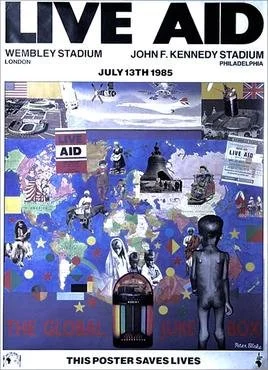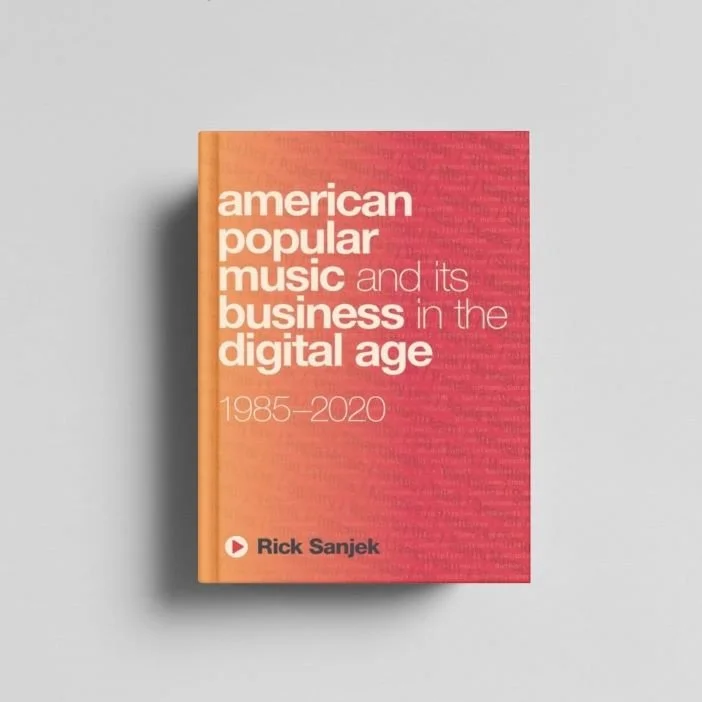Live Aid at 40 – Rock ’n’ Roll at its Charitable Finest!
Adapted from American Popular Music and Its Business in the Digital Age – 1985-2020
By Rick Sanjek © 2025
The music industry has a long history of supporting charitable causes with fundraising events including the T.J. Martell Foundation, the United Jewish Appeal, the American Cancer Society, the City of Hope, St. Jude Children’s Research Hospital, and other favorites of the top record and publishing executives. Annual dinners normally have an honoree from the upper ranks of the industry whose company led that year’s fundraising by selling high-dollar dinner tickets, supplying the night’s entertainment, and soliciting ad buys in the dinner program and a Billboard supplement. Hundreds of millions of dollars have been raised for charity in this manner.
Artists also have a history of charitable events but of a much more spontaneous nature in reaction to a calamity or crisis in which the artists donate their services with all proceeds going to the supported cause.
In 1971 George Harrison and Ravi Shankar set the standard with the Concert for Bangladesh, which spawned a live album, movie, and eventually a DVD. Over the next decade a who’s who of top acts banded together in concerts for charities Amnesty International, UNICEF, and Musicians United for Safe Energy (MUSE), an anti–nuclear energy advocate.
In late 1984, the power of pop star charity reached a new high with a Christmas recording created by Irish rocker Bob Geldof and Scottish collaborator Midge Ure. Do They Know It’s Christmas? was inspired by a BBC telecast on the famine in Ethiopia.
Phil Collins, Boy George, Paul McCartney, David Bowie, Paul Young, George Michael, and members of U2, Duran Duran, Kool & The Gang, Spandau Ballet, and Bananarama were among the 43 artists performing on the record under the group name Band Aid. The record stayed at number one in the UK for five weeks during the Christmas season and sold over three million copies by January, becoming both the fastest- and biggest-selling single in UK chart history. Another estimated 2.5 million copies sold in the US. In its first year the record raised over $9 million.
After hearing Do They Know It’s Christmas? artist/activist Harry Belafonte contacted Lionel Richie and Kenny Rogers manager Ken Kragen about doing a similar American project. Kragen was known to Belafonte for his work with the late Harry Chapin on anti-hunger activism. On January 21, 1985, Kragen got Richie together with Michael Jackson to write a song, then brought in Quincy Jones to produce, and on January 28 they began recording We Are the World.
In order of appearance, Lionel Richie, Stevie Wonder, Paul Simon, Kenny Rogers, James Ingram, Tina Turner, Billy Joel, Michael Jackson, Diana Ross, Dionne Warwick, Willie Nelson, Al Jarreau, Bruce Springsteen, Kenny Loggins, Steve Perry, Daryl Hall, Huey Lewis, Cyndi Lauper, Kim Carnes, Bob Dylan, and Ray Charles all sang on lead lines. Another 28 vocalists and musicians including Belafonte and Jones joined in, all under the group name USA for Africa.
We Are the World reached number one in America, stayed there for five weeks, and topped the charts in another ten countries. It sold over 20 million units worldwide, making it the biggest-selling single of all time. It was accompanied by a studio performance video clip, a home video on The Making Of…, T-shirts, additional merchandise, and a Life magazine special edition. On Good Friday, 1985, over 8,000 radio stations around the globe participated in a simultaneous worldwide radio broadcast. In the first year after the single’s release, $44.5 million was raised for African hunger relief, to eventually total over $63 million.
Design by Peter Blake.
Geldof and Ure then organized the July 13, 1985, televised Live Aid concert performance, held simultaneously before a crowd of 70,000 at Wembley Stadium in London with production handled by Harvey Goldsmith, the producer of the Prince’s Trust Fund concerts, and 100,000 at Philadelphia’s JFK Stadium with production under the supervision of Bill Graham.
Performances at each venue were shown live on giant video screens in the other. More than 75 acts performed, including Elton John, Madonna, Santana, Run-DMC, Sade, Sting, Bryan Adams, The Beach Boys, Mick Jagger, David Bowie, Queen, Duran Duran, U2, The Who, Tom Petty, Neil Young, and Eric Clapton.
Satellites transmitted the live broadcast to more than 1 billion viewers in 110 countries, with 40 of them holding telethons for African famine relief during the broadcast. Phil Collins flew by Concorde after his London performance to New York and helicoptered to Philadelphia to perform again, this time as drummer for a reunion of the surviving members of Led Zeppelin. Crosby, Stills, Nash & Young reunited for the show.
Queen’s twenty-one-minute set was hailed by all with none other than Elton John, who preceded them that day, telling Queen’s Freddie Mercury, “Well, nobody needn’t go on now Freddie, you’ve just completely and utterly swept the board.”*
At the end of the London segment Paul McCartney and Pete Townsend held Bob Geldof on their shoulders to lead a closing performance of Do They Know It’s Christmas? while the Philadelphia show ended with an ensemble version of We Are The World. It was one of the most awe-inspiring events in the history of the music business.
Live Aid eventually raised $127 million for African famine relief and created enough attention and action from the world community to supply surplus grain to end the then-current hunger crisis. A year later Geldof was knighted for his efforts. Twenty years later in 2005 Ure received his belated knighthood as well.
Live Aid was by no means the only charitable endeavor by the music industry’s creative community, though none could compare with Live Aid’s one-time impact and inspiration for the decades to come with artist-organized events including Farm Aid, now in its 40th year, and the Conspiracy of Hope US Tour and the Human Rights Now! World Tour, both for Amnesty International.
With all the 1950s teens that had been inspired by Elvis over the age of 40 by 1985, and the baby boomers close on their heels, Live Aid had marked Rock ’n’ Roll’s coming of age with its social consciousness and cultural relevancy for all to see on a massive scale.
Adapted from American Popular Music and Its Business in the Digital Age – 1985-2020
Published by Oxford University Press© Rick Sanjek 2024
Footnote:
* Rory O’Conner, “Elton John in tears after revealing emotional Freddie Mercury story,” smoothradio.com, November 20, 2019; Elton John in tears after revealing emotional Freddie Mercury story: "You can imagine... - Smooth


